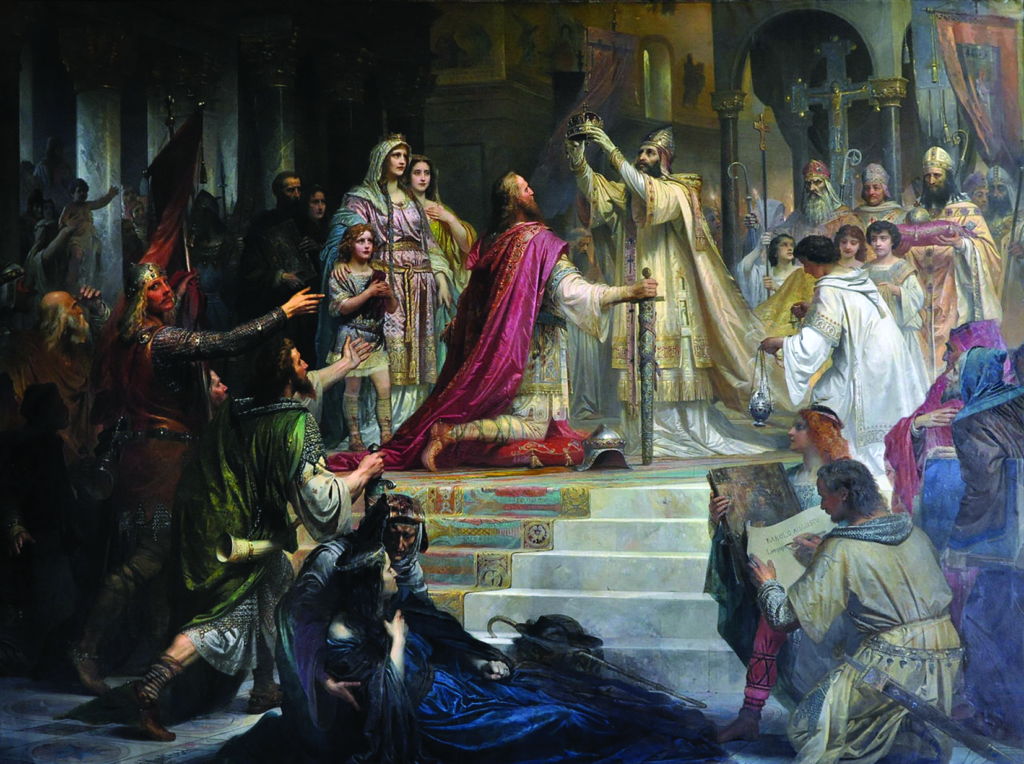These are the two olive trees, and the two candlesticks, that stand before the Lord of the earth.~ Apocalypse 11:4
Christ is the invisible Head of the Church. The Pope is the visible head. Catholic monarchs shared in the Kingship of Christ over the temporal world, with the Holy Roman Emperor as the first among monarchs. In that, they were perhaps rivaled by the Kings of France, who also saw themselves as heirs of Charlemagne. Unfortunately, the rivalry between the House of Austria and the House of France led to ruinous wars which rent the body of Christendom. From Inside the Vatican:
ShareThe Pope is not now, and never has been, the “Head of the Catholic Church.” There is only one “Head of the Catholic Church” and that is our Lord and Saviour, Jesus Christ. He, and He alone, is the true “Head of the Catholic Church.” The Pope is, as his age-old title reminds us, the “Vicar of Christ,” i.e., a kind of “prime minister” of Christ. Moreover, the Pope is only the spiritual Vicar of Christ. He is not the temporal Vicar of Christ.
In the ages of faith, indeed, right up until Napoleonic times, every Catholic knew that the temporal Vicar of Christ was the Emperor (or, more fully, the Holy Roman Emperor) and he was treated as such by the Church and by every Pope that reigned in those days. Indeed, he was prayed for on Good Friday, and at the Easter Vigil, directly after the Pope and clergy, right up until those imperial prayers were removed by Archbishop Bugnini in 1954.
It is an oft-forgotten fact that the Popes were purely temporal subjects of the emperors for most of Christian history. The Papal States had been “feued” (granted) to Pope Stephen II, in 756, by King Pepin the Short, the father of an emperor, Charlemagne, who later confirmed the same. Thus it remained until the very end of the Empire in 1806, when it was effectively dissolved by Napoleon Bonaparte, the destroyer of old Christendom.
True, the Popes became virtually independent from about 1300 but, even then, they were still, technically and legally, temporal subjects of the Emperor and acknowledged themselves to be such. Even the Duchy of Rome, which the Popes occupied prior to the so-called Donation of Pepin, was a territory feued from the Eastern Emperor.
It was on Christmas Day 800 AD that the nobility, clergy and freemen of the City of Rome transferred their allegiance from the Eastern Emperor (actually Empress Irene) and, by acclamation, elected (as was the traditional method of choosing emperors, just as Popes) Charles, King of the Franks, to be the renewed Emperor of the Romans in the West, Caesar semper Augustus et Imperator. This was with the blessing of Pope St. Leo III who then crowned him in St Peter’s Basilica as we are told by Einhard, the chronicler of the life of Charlemagne in his Vita Caroli Magni.
Pope St. Leo III had given his blessing to this translatio imperii (transfer of the imperial power) not only because of the failure of the Eastern empress, Irene, to come to the aid of the Popes, under constant threat from the Lombards, in contrast to Pepin and the Franks, but also because she had usurped the imperial throne from her own son, Constantine VI, and connived at his blinding, from which assault he had died. In a proper approach to the distinction between clerical and lay power, advice and blessing was first sought from the spiritual Vicar of Chris, Pope Leo III. (Read more.)


















No comments:
Post a Comment